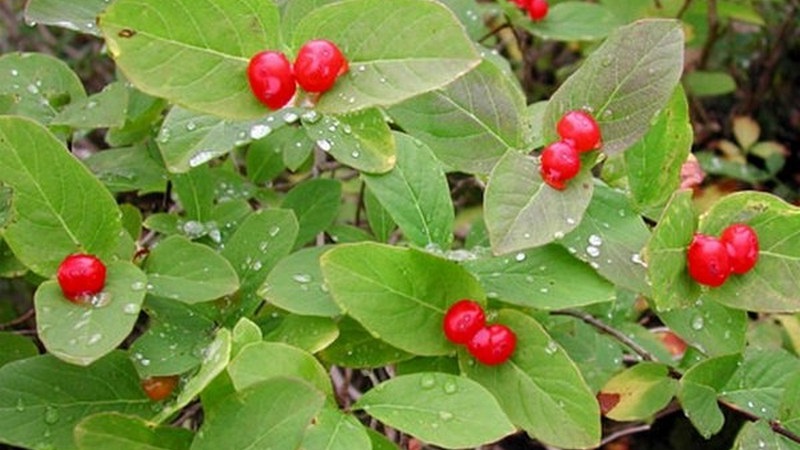What is wild honeysuckle, where does it grow and what is it used for
Forest honeysuckle, or real, is popularly called wolf berry. Small reddish fruits have a glossy shine and ripen at the end of July. The shrub is often found on forest edges, ripples and next to ravines, and is widely cultivated in household plots.
How poisonous honeysuckle looks like, how it is used in folk medicine and cosmetology - read in our article.
The content of the article
Description of real honeysuckle
Real honeysuckle, common honeysuckle and wolfberry (Lonicera xylosteum L.) - all these are the names of a wild-growing shrub, a species of the genus Honeysuckle, the Honeysuckle family (Caprifoliaceae).

The plant was named after Adam Lonitzer, a botanist and physicist from Germany... Initially, Karl Linnaeus planned to call it Caprifolium, since European gardeners cultivated honeysuckle honeysuckle - fragrant, curly shrub.
Reference. Karl Linnaeus - Swedish biologist, zoologist, naturalist, founder of a unified classification system for animals and plants.
The table provides a botanical description of the shrub:
| Parameters | Specifications |
| Order | Teasers |
| Department | Angiosperms |
| Class | Dicotyledons |
| Height | 1.5-2.5 m |
| Bark | Brown-gray or gray, with thin stripes |
| Escapes | Red or green |
| Leaves | Simple, ovoid or elliptical in shape, slightly pointed. The upper part is dark green in color, matte, the central vein is purple. The lower part is gray, with dense pubescence. Length - 3-7 cm, width - 2-5 cm. |
| Flowers | Irregular, two-lipped, grow in pairs in the leaf axils. Peduncle is glandular, 1-2 cm long. Bracts are pubescent, ovoid. The calyx is five-pronged. Corolla length - 1-1.5 cm. The color is yellow-white at the beginning of flowering, yellow at the end. |
| Flowering period | May June |
| Fruit | The berries are round, dark red. Diameter - 5-7 cm. Fruits grow together in pairs at the base and hang on the stalks with a light edge. |
| Sustainability | The shrub tolerates shading and drought well. Differs in winter hardiness, unpretentious to urban conditions, grows on any type of soil. |
Interesting on the site:
When and how to plant honeysuckle in fall
There are other related and similar species in nature.:
- Golden honeysuckle (Lonicera chrysantha Turcz.) Grows in the Kuril Islands and Sakhalin. The leaves are large, ovoid. The kidneys are fusiform.
- Ruprecht's honeysuckle (Lonicera ruprechtiana Regel) grows in the basin of the Amur River and Primorye. The leaves are oblong. The kidneys are small, ovoid.
- Tatar honeysuckle (Lonicera tatarica L.) grows in Kazakhstan, Siberia, Altai, in the Middle Volga region. The leaves are smooth, ovoid. The flowers are paired, pink. Fruits are round, orange or red, inedible.
- Smelling, or goat, honeysuckle (Lonicera caprifolium L.) grows in the south of Europe, beyond the Caucasus, in the Crimea. The flowers are reddish or white, turning yellow at the end of flowering. The fruits are red.
- Blue honeysuckle (Lonicera caerulea L.) grows in the Far North within the temperate zone. Leaves are elliptical. The berries are edible, bitter-sour in taste, oblong-elliptical, bluish, with a slight bluish bloom. Flowers are white-yellow, bell-shaped, almost regular in shape.
- Curly honeysuckle (Lonicera periclymenum L.) grows in Northern Europe. Leaves never grow together.
- Georgian honeysuckle (Lonicera iberica Bieb.) Is widespread in Georgia. Differs in red-yellow flowers, red fruits.The wood is dense, suitable for making turning crafts.
- Caucasian honeysuckle (Lonicera caucasica Pall.). The flowers are purple. The fruits are black. Leaves are simple, lanceolate.
- Honeysuckle Maksimovich (Lonicera maximowiczii Rupr.) Grows in the Khingan Mountains, near the Amur. Leaves are elliptical or oblong-ovoid, dark green in color. The flowers are red-purple, grow in pairs, each hiding under its own leaf. The fruits are egg-shaped, bright red, glossy, grow together in pairs, at the end they diverge, like horns.

Berries are poisonous or edible
Real honeysuckle fruit tastes bitter and inedible... Some sources describe them as poisonous. People call them "wolfberry".
The fruits contain a toxic substance - the glycoside xylosteine. When eating berries, poisoning occurs.
Signs:
- nausea;
- vomiting;
- pain in the stomach;
- diarrhea.
Treatment: gastric lavage with 0.1% potassium permanganate solution or intake of activated carbon at the rate of 1 tab. per 10 g of body weight.
Where does the wolfberry grow
Common honeysuckle grows in the undergrowth of mixed and coniferous forests, ravines, near rivers... Growing territory: Ural, Central, Northern and Eastern Europe, Caucasus, Siberia. In household plots, the shrub is cultivated as an ornamental plant.
In heavily shaded areas, honeysuckle practically does not bloom, therefore, has adapted to the vegetative way of reproduction.
Reference. In the south of Russia, common honeysuckle does not grow in the wild.
Uses of wild honeysuckle
Shrubs of real honeysuckle are used in landscape design for landscaping the local area. After pruning, the plant holds its shape for a long time and looks attractive.

The berries have not been used in cooking because of the bitter taste and toxicity.
Leaves, twigs and fruits are used in folk medicine and home cosmetology... Pharmaceutical companies add the plant extract to medicines as an excipient.
Take a note:
How to freeze honeysuckle as juice, puree, and whole berries
In folk medicine
From young shoots, leaves and flowers they prepare wound healing, laxatives, vomiting, antibacterial, pain relievers. The fruits, despite the bitterness and toxicity, are used in small quantities in homeopathy for the treatment of the central nervous system, liver, bronchi, and gallbladder. Flowers, leaves and stems are harvested in June, berries in September.
Infusions from dry raw materials are used for treatment of the genitourinary system, elimination of edema. In homeopathy, this plant is used for diseases of the liver, nervous system, gallbladder, as well as for coughs or asthma.

A decoction of flowers and leaves is used when flatulence and intestinal colic.
Poultices help get rid of mastitis, furunculosis, purulent wounds and abscesses.
A rich infusion of leaves and flowers is used to treatment of eczema and dermatitis.
The extract from the leaves is used in pharmacology as a component of mixtures for sputum removal.
A decoction of young shoots and leaves is effective in treatment of the gastrointestinal tract and kidneys. It is also used to gargle with purulent sore throat.
Traditional healers recommend using an infusion of leaves and shoots for the treatment of eye diseases.
Pasta is prepared from fresh crushed leaves for the treatment of poorly healing wounds. Powder is made from dry foliage and sprinkled on wounds.
Reference. Etymologists believe that the Russian name "honeysuckle" comes from the ancient Slavic words "zhi" (goat) and "molst" (to milk). The fact is that the leaves of the plant are eaten with great pleasure by sheep and goats, whose milk has long been consumed by people.
In cosmetology
In cosmetology, honeysuckle is used for the preparation of care products for dehydrated, aging skin.The extracts of the plant have a rejuvenating, tonic effect, eliminate the manifestations of rosacea, acne, smooth the network of fine wrinkles, lighten age spots.
Often, the fruits and leaves of honeysuckle, honeysuckle, are used with a high content of rutin, vitamin C and flavonoids.

Harm and contraindications
Honeysuckle berries are forbidden to eat due to the high risk of poisoning.
Direct contraindication to the use of folk remedies - individual intolerance and allergies.
Conclusion
Wild honeysuckle, edible forest, real or common - the names of one shrub. It is often used in landscape design to beautify the local area. The plant is distinguished by unpretentious care, retains its shape well after cutting, looks attractive thanks to white or white-yellow flowers and small red berries.
The fruit of real honeysuckle is not recommended to be eaten due to the content of the glycoside xylosteine, which has toxic properties. Berries are rarely used in homeopathy to treat the liver, nervous system, gall bladder, bronchi. Young shoots, flowers and leaves are harvested for future use. They are used to prepare infusions, decoctions, lotions, powders for the treatment of skin diseases, gastrointestinal tract, kidneys, genitourinary system.
In cosmetology, honeysuckle is used no less actively. Masks and lotions restore skin elasticity, natural shine, whiten age spots and freckles.